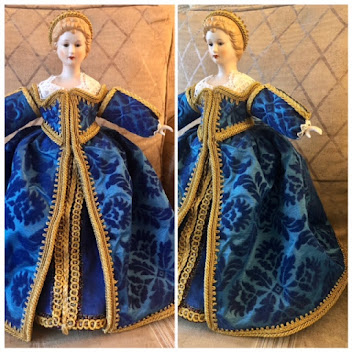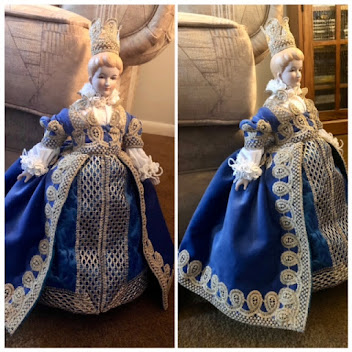Full and 1/2 Scale Mannequins/ Dolls in Fashion
 |
| 1/4 scale model of Eleanor of Toledo Italian Gown From Patterns of Fashion The School of Historical Dress. |
Back to Topic at hand, I noticed that several people try 1/2 scale paper patterns and eventually make miniatures fabric toiles to better understand the shapes and pattern behavior before working on a full scale clothing piece. Not sure if this practice comes from fashion school teaching, or if its roots go back much further. In some images of recent classes given at the School of Historical Dress, they seem to also use this method to help the students understand the shapes they are using and how they are supposed to behave. I love looking at all the pictures of the half scale work in the classes and want to better try my hand at it. They were scaling patterns up from Patterns of Fashion 3 and 5 by Janet Arnold.
 |
| Archduke Albert of Bavaria Doll in the V&A |
There was a project the School of Historical Dress did back in 2016 making 1/2 scale dressed dolls, representing Archduke Albert of Austria and Archduchess Isabella Clara Eugenia. These were hand-carved in lime wood (linden for the American version). The styling of the clothes were about 1615 and made from materials appropriate to aristocrats of the early seventeenth century. Skin out dress in separate layers. Linen smock, a satin pair of bodies, satin sleeves, Spanish farthingale, Velvet forepart, velvet gown for Isabella. Albert has a linen shirt, satin doublet, woolen hose and velvet cloak. Each doll also has to scale set of appropriate leather shoes. Truly little works of art made possible by a grant from the Early Dress and Textiles Network from the Arts and Humanities council and the doll are in the Learning Department of the V&A.
 |
| Archduchess Isabella Clara Eugenia Doll in the V&A |
For someone who makes dolls like myself this is a curious cross over from doll scale to human scale. I have one book An Illustrated Guide to the Dolls as used in Fashion that references large scale models life size sent commissioned by one Royal and consequently sent to another royal of a different court in the 1490's. Later these similar life size dolls to the Americas from France in the 18th century to allow women to rent the mannequin/ doll and take to to a tailor to order a dress to be made. When the gown was complete the doll/mannequin would be brought back from someone else to rent. I don't think this method of traveling fashion was created over night in the 18th century. This was evident of the trade of fashion dolls among the royal fashion elite of Europe since pre-16th century. Evidence of the inventory of Henry Viii, Inventory of Catherine de Medici, Inventory of Marie Queen of Scotts, and references in Inventory of Queen Elizabeth.
Fashion Dolls were used to show fashions in a particular season on regional areas, used by royalty for gifts in conjunction to alliances and marriage contracts. Although this source is the only one that talks about size. Queen Elizabeth Wardrobe Unlock'd references fashion dolls and has a quote from the Mistress of the Queens Wardrobe at the time Elizabeth Von Snakenborg to her sister on the continent. Plus it reference the Extant one in the Royal Swedish Armory but that is a much smaller one. The image of the portrait painting of Arabella Stuart age 2 from Hardwick Hall, holding her fashion doll. Although no reference to size is made in this area of the book.
In order to safely allow the layers to be removed, as this was a question in my last judging of my doll in the Kingdom Arts and Sciences Competition. A larger scale some thing 1/4 of 1/2 scale would need to be considered. I could make full scale but I want this more to be a doll than a mannequin. Although I feel any tailor worth their salt could take a pattern from a 1/2 scale and make it larger and make all the necessary adjustments to fit a person. Portability also needs to be taken in account. It would have been expensive to ship fashion dolls full size, although its been done according to my source.
The wooden dolls would have not been made by the tailor themselves. As the Guild system in Europe and England are well established now but were slightly at infancy in the late Medieval times. Each skilled job had a guild and there are new one made in England today. The dolls would have been commissioned from a trained woodworker of skill and warrant. So references to size; 1/2 scale would be 36" tall, 1/4 scale would be 18" tall. So the next dolls will be of considerable size.
Yes I will be making the wood doll from scratch by my own hand. At this point in my gathering, I have a later pattern wood doll for reference. Although a jointed doll would have been needed to dress easier than just non jointed. So some newer skills will be on show besides my sewing embroidery, wig-making, painting and the like. I am gathering my hair for the wig as well. Woodworking/ woodcarving a new skill will be on display.Now to figure out the kind of likeness I want to make pre-16 England. This will also end up in the book of Dolls, because it has to have all the scales.
Time to create the Masterpiece,
THL Marrin O'Kealy





No comments:
Post a Comment